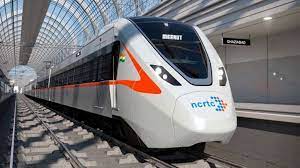29 Jan 2022 Regional Rapid Transit System (RRTS)

- Recently Regional Rapid Transit System (RRTS) officials estimated that RRTS will reduce carbon dioxide emissions by taking about 1.5 lakh private vehicles off the road.
- This corridor will start from Sarai Kale Khan in Delhi and reach Modipuram in Meerut (Uttar Pradesh) via Ghaziabad.
- First of its kind RRTS in the national capital whose average speed of train on track will be 100 kmph and passengers will be able to reach Meerut in 50-60 minutes.
Role:
- A task force was constituted by the Planning Commission in the year 2005 under the chairmanship of the Secretary, Ministry of Urban Development to develop a multi-modal transit system for the National Capital Region (NCR).
- It was included in the Integrated Transport Plan for NCR 2032 with special emphasis on ‘Regional Rapid Transit System’ (RRTS) connecting regional centres.
- The Task Force identified 8 corridors and prioritized three corridors for implementation, namely Delhi-Meerut, Delhi-Panipat and Delhi-Alwar.
About RRTS:
- The ‘Regional Rapid Transit System’ is a new, high speed, high capacity, comfortable commuter service connecting regional nodes in NCR.
- RRTS is also different from conventional railways as it is more reliable and completes more cycles with higher speed.
- RRTS differs from Metro in that it has fewer stops and higher speed than Metro and caters to the needs of passengers traveling relatively longer distances.
Desired benefits:
- Environment friendly: The corridor is estimated to emit 2.5 lakh tonnes of CO2 less than the total annual greenhouse gas emissions, making the city cleaner and a better place to live.
- Economic growth: The share of use of public transport along the corridor is projected to increase from 37% to 63%.
- High-speed connectivity will result in balanced economic development of the entire region, bringing economic benefits to all sections of the society and multiple points of development, rather than all economic activity taking place in one place.
- Sustainable Urbanization: This project will serve as a model for developing high capacity rapid urban transit corridors in other urban areas of India.
- It will help in reducing traffic congestion in NCR and overall emissions from the transport sector.


No Comments